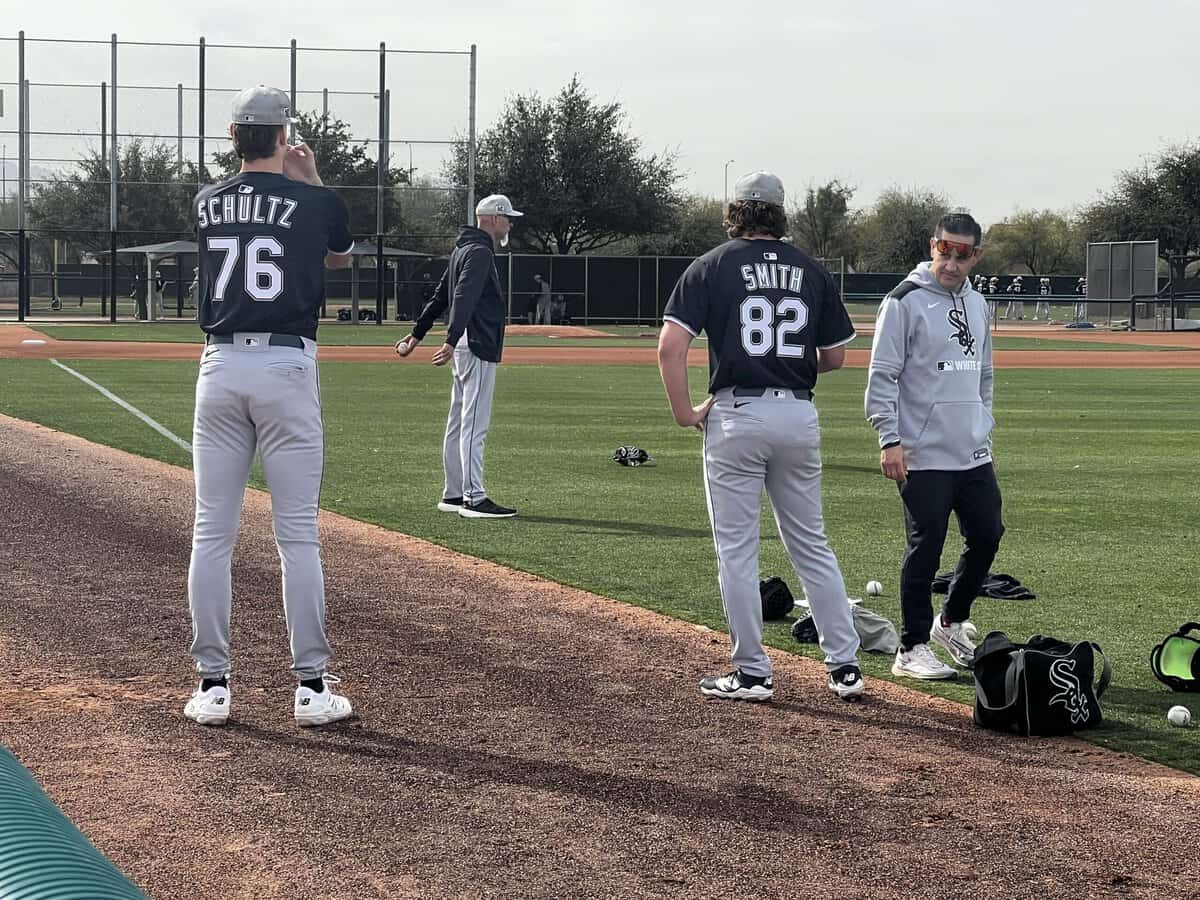White Sox relief prospect Peyton Pallette is struggling at Triple-A Charlotte, even while sitting 95 mph. After striking out 32 compared to just 20 baserunners allowed in 21 innings at Double-A Birmingham, Pallette has allowed 11 runs in 7 innings since his promotion.
Discussing a scuffling reliever is usually an odd way to start a rundown of the top pitching prospects in the organization, but his situation could have broad ramifications.
"The switch to the major league balls is a big [element] of what is going on right now," said pitching coordinator Matt Zaleski. "He lived primarily off fastballs in Birmingham with the minor league balls. He was a getting a ton of movement, a ton of swings and misses. You cut him over to the major league ball, he's getting a little less movement and it's just not performing as well as it has been in Birmingham, so we're going to have to call an audible for his usage."
Pallette has a slider, curveball and -- in this writer's opinion -- a gorgeous changeup that piles up whiffs, and Zaleski speaks as if leaning on them more was a progression the 24-year-old right-hander was always going to need to make at some point to hit their potential. But since top prospect Noah Schultz is about to make the same transition to using major league balls at Truist Field, is he about to run into a similar issue?
Yes and no.
"He's not the guy who relies on 16-17 [inches of] vert with the minor league ball," Zaleski. "He's more of a sinker, slider, changeup and occasional four-seam guy, more of a groundball-style pitcher. So I don't think the major league ball is going to affect him from that standpoint. His movement might actually improve, as we've seen with sinkerballers and slider guys because the seams are tighter and the ball is wound tighter. Sometimes they're able to grab extra movement."
As the White Sox have worked to reclaim the rotational elements of Schultz's delivery, Brian Bannister was further optimistic that it will return some of the seam effects late-movement to his pitches to make the left-hander a weak contact machine. However, the plan for Schultz to attack righties (who have .889 OPS against him, but also a .419 BABIP) without using the cutter that seemed to be jostling his mechanics, is more four-seamers to the up-and-away quadrant.
Chris Sale gets mentioned a lot for how this attack plan might look.
⚙️⚙️⚙️
When Hagen Smith returns to game action, expected to be later this month, it will probably look like a spring training outing, where he's gradually built back up from outings of one or two innings in length.
"Nothing crazy, not going to ramp him up to five innings in like, two weeks," Zaleski said. "But it should allow him to not hit his innings cap until the end of the year."
After he walked 20 batters in 25⅔ innings (while also striking out 42) the White Sox took the mission of how to restore Smith to his Arkansas form quite literally, conferring with their pitching coach Matt Hobbs on the differences between the left-hander's present and past mechanics. Smith's quick and compact arm action is appealing, but the Sox found that his entire operation had become rushed, drawing away from his literal strengths.
"We've been able to leverage some of our newer data sources and just really identify that he wasn't using his legs optimally, both on the back leg and the front leg and he was losing his stack," said Bannister.
His stack?
"It's just staying upright," Bannister explained. "You could see he had a forward tilt with everything and he was diving, which was causing his arm to have to be too quick and he wasn't generating his ideal ground force. He's crazy strong. So once we got in the newer lab with new force plates, we were able to see that he was definitely not generating his ideal force and breaking, and it was because he was rushing and that's why he was spraying the ball more."
After a battery of drill work to get Smith back to his old mechanics, the Sox are hoping they've killed two birds with one stone, restoring the No. 5 overall pick's strike-throwing, but also getting him to assign more stress in his delivery to his powerful legs and away from his elbow.
"The elbow issues stemmed probably from just diving down the mound too much and his arm not catching up," Zaleski said. "He's doing a better job of not doing that, controlling his center of mass throughout his delivery and getting through his front leg better."
⚙️⚙️⚙️
The White Sox have been trying to restore Jairo Iriarte to his 2023 mechanics really ever since they acquired him last spring. While Colson Montgomery garnered plenty of attention for spending time at Camelback Ranch in May, Iriarte's own less-publicized month-long Arizona sabbatical was geared around restoring the carry to his four-seamer. For that, Zaleski said the Sox gave Iriarte drills aimed increasing the trunk tilt to his left side, in an effort to restore the axis of his release to past versions of his delivery where his stuff was the nastiest.
Normally, in the prospect world, "trunk tilt" is something often identified as a delivery issue that can sap command and make it hard for pitchers to repeat their motion reliably enough to start.
And well, that could be a potential sacrifice.
"There is command risk when you do it, but you get to the point of positive versus negative," Zaleski said. "Is it more positive for him to have a little less command, but have a better overall performing fastball and arsenal? Or would you rather have the better command with the lesser-performing fastball and arsenal? When you weigh out those two, you might as well take the sacrifice of command and lean into the better-performing pitch that's going to get more swings and misses and soft contact."
Accordingly, there are no immediate plans to move Iriarte back to starting, as the Sox hope he can build some confidence in short outings with boosted stuff. Through four outings since returning to Charlotte, Iriarte has allowed one run in six innings, striking out eight and walking three. The logic stands, that if Iriarte feels like he has pitches he can attack the zone with, maybe the walk numbers come down organically, even with less precision.
"As a guy myself who didn't have very much stuff, when you execute a quality pitch and they whack it, it's not a fun feeling," Zaleski said.
⚙️⚙️⚙️
Despite being four years removed from being drafted, burly right-hander Tanner McDougal is still just 22, and just earned a promotion to Double-A Birmingham. He's bizarrely still searching for his first win since picking up the victory in his first-ever professional game 61 outings ago back in 2021, but McDougal channeled his always-electric stuff into 46 strikeouts in 33⅔ innings over his last seven starts, walking just 14 and sporting a cleaner line to the plate.
"He lands a little bit closed," Zaleski said. "But for him with the landing closed, all we ask for is good stability on that lead leg, and not being rolling over it and losing his center of mass. That's when you start to see the sprays happen, which he kind of had last year at times. He just didn't have the stability on it or would go too far cross-body and that would happen, but he's been excellent from this year from that standpoint."
McDougal's electric stuff and bouts of wildness had Sox officials openly discussing how his sluggish development up to this point might accelerate upon a transition to relief, but he's worked to push such thoughts aside so far in 2024.
"He matured a lot in the offseason," Zaleski said. "He took his career into his own hands, invested in himself. Work ethic has gotten significantly better. Major props to Tanner because it's what we all wanted for him and he's gone out and done it himself. It's been great to watch. He's not afraid to come back in the zone if he's behind in the count with almost any pitch now. It's showing."





